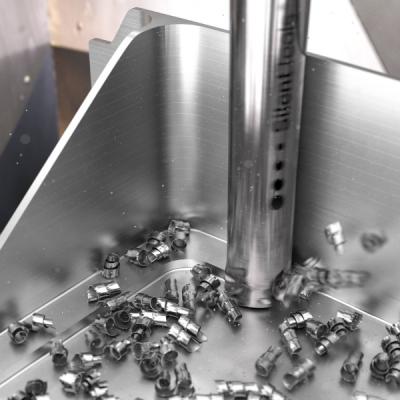
In response to both the growth in quantity and complexity of structural aerospace components, an updated range of CoroMill 390 Silent Tools has been developed by Sandvik Coromant. The upgraded Silent Tools dampening technology will allow machine shops to machine deep pockets on titanium aerospace frame parts with greater security and higher metal-removal rates.
“Driven by increasing passenger travel demand and accelerated asset replacement cycles, the commercial aerospace sector is expected to continue its decade-long trend of above-average growth rates,” says Thomas Wikgren, product manager, shoulder milling at Sandvik Coromant. “In tandem with more advanced component design, including the increased deployment of deep pockets in structural parts (to save weight and fuel), there is a corresponding need to produce these features as efficiently as possible while maintaining the highest quality levels. As a result, CoroMill 390 end mills with integrated damping Silent Tools technology have been updated to take pocket machining to the next level.”
Pockets are the most common feature in titanium structural parts for aircraft, often featuring depths of more than four times the diameter of the cutter, which is significant in such a challenging material. For this reason, there are high demands for process stability and quality, as well as metal-removal rates.
With these factors in mind, the development of an effective cutting tool offers machine shops the opportunity to achieve genuine competitive gain. CoroMill 390 Silent Tools provide light-cutting insert geometries and high performance grades that deliver low cutting forces and vibration-free machining for secure, cost-effective milling.
The new CoroMill 390 Silent Tools can be ordered in diameters from 20 to 32 mm. It is available for both the new insert size 07, as well as insert size 11, with options for either cylindrical shank or Coromant Capto coupling.
Contact Details
Related Glossary Terms
- gang cutting ( milling)
gang cutting ( milling)
Machining with several cutters mounted on a single arbor, generally for simultaneous cutting.
- milling
milling
Machining operation in which metal or other material is removed by applying power to a rotating cutter. In vertical milling, the cutting tool is mounted vertically on the spindle. In horizontal milling, the cutting tool is mounted horizontally, either directly on the spindle or on an arbor. Horizontal milling is further broken down into conventional milling, where the cutter rotates opposite the direction of feed, or “up” into the workpiece; and climb milling, where the cutter rotates in the direction of feed, or “down” into the workpiece. Milling operations include plane or surface milling, endmilling, facemilling, angle milling, form milling and profiling.
- shank
shank
Main body of a tool; the portion of a drill or similar end-held tool that fits into a collet, chuck or similar mounting device.

